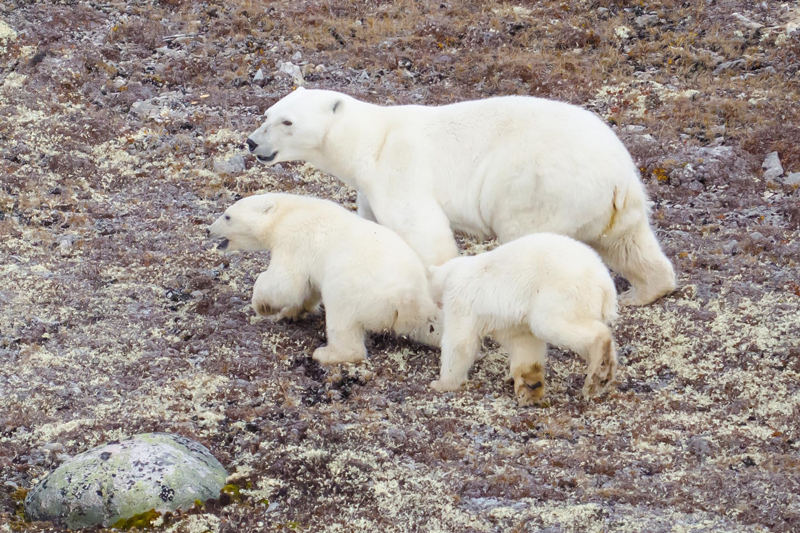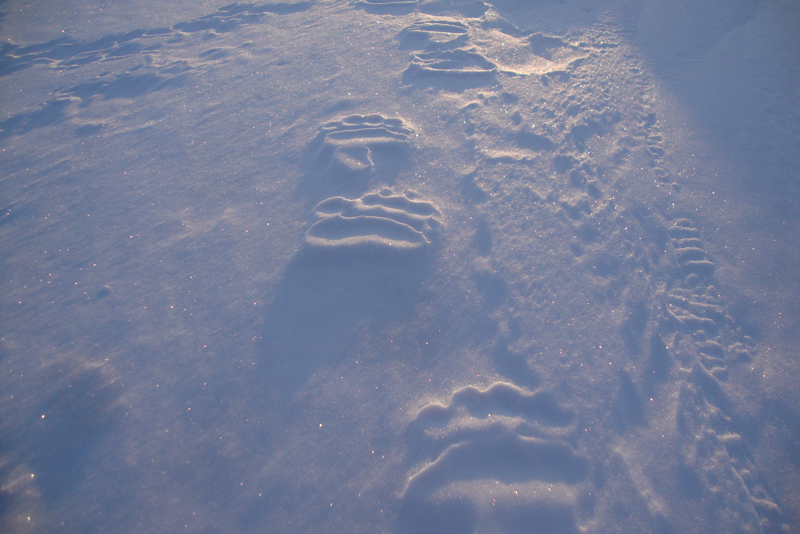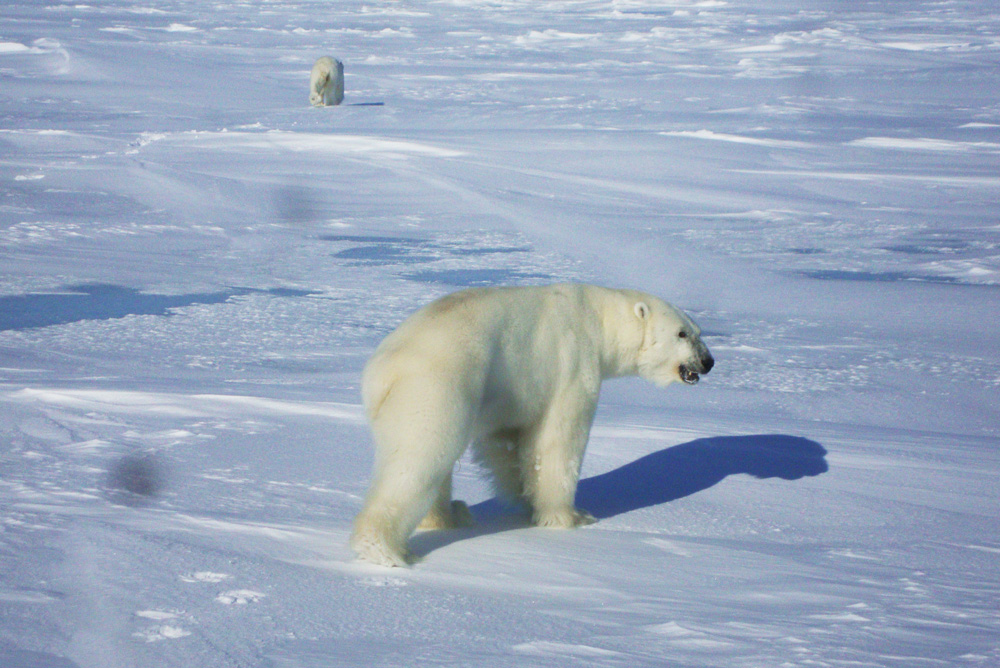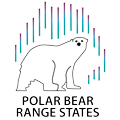 Photo credit: Peter Hale, Department of Environment, Government of NunavutCanada is home to 13 polar bear subpopulations and approximately two-thirds of the global polar bear population. The subpopulations are located in and adjacent to the provinces and territories across the country’s north. Three subpopulations are shared with Greenland and one is shared with the United States. Canada’s polar bear management system is grounded on both science and Traditional Ecological Knowledge (TEK). The latter provides invaluable information from those who live in the polar bear habitat about migration patterns, denning habits and observed changes in the movements/habits of polar bears.
Photo credit: Peter Hale, Department of Environment, Government of NunavutCanada is home to 13 polar bear subpopulations and approximately two-thirds of the global polar bear population. The subpopulations are located in and adjacent to the provinces and territories across the country’s north. Three subpopulations are shared with Greenland and one is shared with the United States. Canada’s polar bear management system is grounded on both science and Traditional Ecological Knowledge (TEK). The latter provides invaluable information from those who live in the polar bear habitat about migration patterns, denning habits and observed changes in the movements/habits of polar bears.
Legislation
In 2011, the polar bear was listed as a Species of Special Concern in the Federal Species at Risk Act (SARA) , which is designed to protect wildlife in Canada. A Special Concern designation is used for species that may become threatened or endangered as a result of a combination of biological criteria and identified threats and warrants the development of a Management Plan. The polar bear is also listed as being at risk under provincial/ territorial legislation in Manitoba, Ontario, Quebec, Newfoundland and Labrador, and the Northwest Territories, and various management plans or recovery strategies are either in place or under development in these jurisdictions.
Habitat Protection
Within polar bear range, Canada has five national wildlife areas, three marine protected areas, 13 national parks and 58 provincial and territorial parks (as of September 2017).
Management System
 Photo credit: Markus Dyck, Government of NunavutPolar bear management is undertaken collaboratively among the federal, provincial and territorial governments and the Wildlife Management Boards. Wildlife Management Boards were established under the various Land Claims Agreements, and are the primary institutes for wildlife management within the territories. Harvest management systems for polar bears are in place across the Canadian Arctic and are based on the best available science and TEK. Decisions on harvest quotas, in those jurisdictions that have a quota system, are made by the relevant Wildlife Management Boards and are implemented and enforced by the responsible Minister. Ultimate decision-making authority lies with the responsible federal/provincial/territorial Minister. The decision-making process is an open one and considers advice provided by a multitude of stakeholders and interested parties, including governments, technical experts (scientists and indigenous peoples) and non-government organizations. The management systems receive broad and overarching support from the federal/provincial/territorial Polar Bear Administrative Committee , which in turn receives technical advice and support from the Polar Bear Technical Committee. Together, the committees work to provide annual assessments on the status of each of Canada’s 13 polar bear subpopulations, draft national action plans and provide advice on matters of national concern about the polar bear.
Photo credit: Markus Dyck, Government of NunavutPolar bear management is undertaken collaboratively among the federal, provincial and territorial governments and the Wildlife Management Boards. Wildlife Management Boards were established under the various Land Claims Agreements, and are the primary institutes for wildlife management within the territories. Harvest management systems for polar bears are in place across the Canadian Arctic and are based on the best available science and TEK. Decisions on harvest quotas, in those jurisdictions that have a quota system, are made by the relevant Wildlife Management Boards and are implemented and enforced by the responsible Minister. Ultimate decision-making authority lies with the responsible federal/provincial/territorial Minister. The decision-making process is an open one and considers advice provided by a multitude of stakeholders and interested parties, including governments, technical experts (scientists and indigenous peoples) and non-government organizations. The management systems receive broad and overarching support from the federal/provincial/territorial Polar Bear Administrative Committee , which in turn receives technical advice and support from the Polar Bear Technical Committee. Together, the committees work to provide annual assessments on the status of each of Canada’s 13 polar bear subpopulations, draft national action plans and provide advice on matters of national concern about the polar bear.
Harvest and trade
Some indigenous (Inuit and Cree) groups have an exclusive right to hunt polar bears in Canada. Indigenous subsistence harvest produces economic benefits for Arctic communities, and polar bear hunting remains an important part of the traditional culture found in northern indigenous communities. In a region where the cost of living is extremely high and economic prospects are scarce, polar bear hunting is a source of nutritious food and provides an opportunity to generate income. Canada permits a controlled, limited harvest of polar bears for subsistence purposes, including profits gained from the sale and international trade of polar bear products. About 2% of Canada’s polar bear population is traded annually, providing a culturally significant way in which northern communities can sustain themselves.
Harvest quotas are established at the subpopulation level through discussions among the relevant jurisdictions and with consideration given to conservation. Canada’s management system is complex, since polar bear subpopulations often fall within more than one jurisdiction and quotas must be divided among multiple communities. All bears killed by humans are deducted from the quotas in a given region, whether they are killed in defense of life or property, for subsistence, during Inuit-guided hunts (sport hunts) or illegally harvested. Sport hunts occur in Nunavut and the Northwest Territories where Inuit hunters are allowed to transfer their exclusive rights under their Land Claims Agreements to another hunter. Sport hunts constitute a small proportion (< 10% in recent years) of the total number of harvested bears, require an Inuit guide and must be conducted using traditional methods (sled and dog team) and with a locally designated quota tag. All aspects of a polar bear hunt are held in very high regard by the indigenous peoples. Those parts of the bear not used by the harvesters and their families or sports hunters are distributed among other members of the community or are entered into trade. When tags for harvested bears are obtained from Conservation Officers, samples are submitted to the responsible government allowing for the sex, age and genetic information of the animal to be recorded and to assist with monitoring research.
National Action Plan
 Photo credit: Markus Dyck, Government of NunavutThe National Polar Bear Conservation Strategy, completed in August 2011, was developed by the Polar Bear Administrative Committee. The goal of the Strategy is to increase the level of coordination and collaboration among all Canadian jurisdictions (provincial, territorial and federal) for the management of polar bears. By increasing collaboration, the Strategy will provide the framework to accomplish the following objectives:
Photo credit: Markus Dyck, Government of NunavutThe National Polar Bear Conservation Strategy, completed in August 2011, was developed by the Polar Bear Administrative Committee. The goal of the Strategy is to increase the level of coordination and collaboration among all Canadian jurisdictions (provincial, territorial and federal) for the management of polar bears. By increasing collaboration, the Strategy will provide the framework to accomplish the following objectives:
- promote actions that contribute to the long-term maintenance of polar bear subpopulations, both within Canada and shared with other countries;
- minimize threats to polar bears and their habitat that result from human activities; and
- ensure that best practice standards for polar bear management and research are adopted and respected, including the continued development of non-invasive methodologies and the incorporation of TEK.
The Strategy defines the roles and responsibilities of each management partner, recognizes the key threats that face polar bears in Canada, and includes an inventory schedule for subpopulation monitoring. The Strategy acknowledges that climate change is an overarching driver of several threats. Other key threats include contaminants, mineral and energy resource development activities, marine shipping, unsustainable harvest levels and human-bear conflicts.
In accordance with listing of polar bears as a species of Special Concern in Canada a national management plan is under development.
For information pertaining to the Convention on International Trade in Endangered Species (CITES), and actions being undertaken by the Government of Canada to conserve and manage polar bears, please visit the Government of Canada website. For general information related to polar bear biology, habitat, threats and protection in Canada, please visit Canada's Species at Risk Public Registry.

